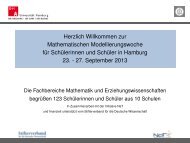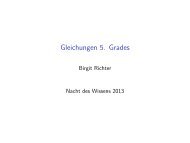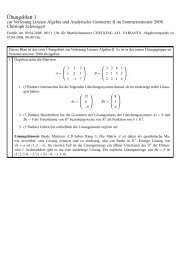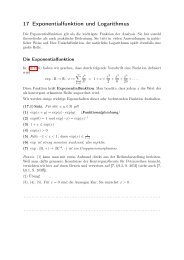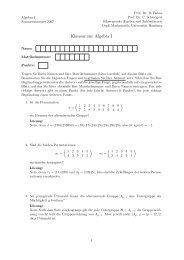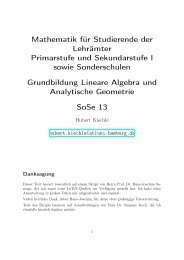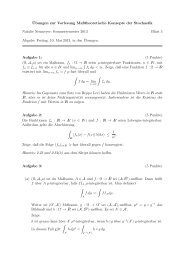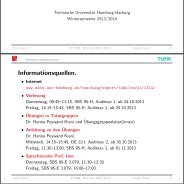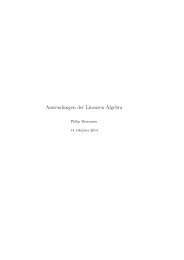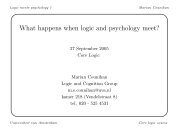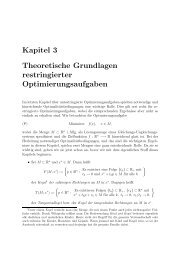pdf file
pdf file
pdf file
Create successful ePaper yourself
Turn your PDF publications into a flip-book with our unique Google optimized e-Paper software.
e the functor which associates to a pair M, N of A-modules their tensor product M ⊗ K N as<br />
vector spaces with the A-module structure given by the morphism of algebras<br />
A<br />
Δ<br />
−→ A ⊗ A ρ M ⊗ρ N<br />
−→ End(M) ⊗ End(N) −→ End(M ⊗ N) .<br />
Then (A−mod, ⊗, (K, ɛ)), together with the canonical associativity and unit constraints of the<br />
category vect(K) of K-vector spaces is a monoidal category, if and only if (A, μ, Δ) is a bialgebra<br />
with counit ɛ, i.e. if and only if (A, Δ, ɛ) is a coalgebra.<br />
Proof.<br />
• Suppose that (A, μ, Δ) is a coalgebra. We have to show that the canonical isomorphisms<br />
of vector spaces<br />
(U ⊗ V ) ⊗ W → U ⊗ (V ⊗ W )<br />
(u ⊗ v) ⊗ w ↦→ u ⊗ (v ⊗ w)<br />
are morphisms of A-modules. Using Sweedler notation, the element a ∈ A acts on the left<br />
hand side by<br />
a.(u ⊗ v) ⊗ w = a (1) .(u ⊗ v) ⊗ a (2) .w = ((a (1) ) (1) .u ⊗ (a (1) ) (2) .v) ⊗ a (2) .w<br />
and on the right hand side<br />
a.u ⊗ (v ⊗ w) = a (1) .u ⊗ a (2) .(v ⊗ w) = a (1) .u ⊗ ((a (2) ) (1) .v ⊗ (a (2) ) (2) .w)<br />
Coassociativity of A implies that the right hand side of the first equation is mapped to<br />
the right hand side of the second equation after rebracketing.<br />
Since the standard associativity constraints in vect(K) obey the pentagon relation, this<br />
relation also holds in A−mod. Similarly, we have to show that the two unit constraints<br />
V ⊗ K → V and K ⊗ V → V<br />
v ⊗ λ ↦→ λv λ ⊗ v ↦→ λv<br />
are morphisms of A-modules. For the second isomorphism, note that<br />
a.(λ ⊗ v) = ɛ(a (1) )λ ⊗ a (2) .v ↦→ ɛ(a (1) )a (2) .λv = a.λv<br />
where in the last step we used one defining property of the counit. The other unit constraint<br />
is dealt with in complete analogy.<br />
• Conversely, suppose that (A−mod, ⊗, K) is a monoidal category. Then<br />
(A ⊗ A) ⊗ A → A ⊗ (A ⊗ A)<br />
(u ⊗ v) ⊗ w ↦→ u ⊗ (v ⊗ w)<br />
is an isomorphism of A-modules, which, upon setting u = v = w = 1 A , implies by<br />
the identities above that the given unital algebra map Δ is coassociative. Similarly, we<br />
conclude from the fact that the canonical maps K ⊗ A → A and A ⊗ K → A are<br />
isomorphisms of A-modules that ɛ is a counit.<br />
✷<br />
30




